Daimler Regency
| Daimler Regency Mk II DF304 and Daimler One-O-Four DF310 | |
|---|---|
 Regency Mark II 3½-litre 1955 DF304 with body by Barker | |
| Overview | |
| Manufacturer | The Daimler Company Limited |
| Production | 1951–1956 |
| Body and chassis | |
| Class | Luxury |
| Body style |
Four-door saloon bodies by Barker or Empress body by Hooper or Special Sports DF302 convertible by Barker |
| Powertrain | |
| Engine | 2952, 3468 or 4617 cc inline six-cylinder |
| Transmission | 4-speed preselector gearbox with fluid flywheel |
| Dimensions | |
| Wheelbase | 114 in (2,896 mm)[1] |
| Length | 195 in (4,953 mm)[1] |
| Width | 70 in (1,778 mm)[1] |
| Height | 62.5 in (1,588 mm)[1] |
| Kerb weight | 2,000 kg (4,409 lb) |
| Chronology | |
| Predecessor | Daimler Consort |
| Successor |
Daimler Majestic DF316 Daimler Regina DF400 |
| Daimler DF300 3-litre engine | |
|---|---|
| Overview | |
| Manufacturer | The Daimler Company Limited |
| Combustion chamber | |
| Configuration | 6-cylinder in-line |
| Displacement | 2,952 cc (180.1 cu in) |
| Cylinder bore | 76.2 mm (3.00 in) |
| Piston stroke | 107.95 mm (4.250 in) |
| Cylinder block alloy | cast iron |
| Valvetrain | OHV pushrod cam-in-block |
| Combustion | |
| Fuel system | Twin S.U. carburettors |
| Fuel type | petrol |
| Cooling system | water |
| Output | |
| Power output | 90 bhp (67 kW; 91 PS) @ rpm |
| Chronology | |
| Predecessor | 2-litre four-cylinder Lanchester Fourteen |
| Successor |
3½-litre and 4½-litre variants (211.6 cu in) and (281.7 cu in) |
| Regency DF304 3½-litre engine | |
|---|---|
| Overview | |
| Manufacturer | The Daimler Company Limited |
| Combustion chamber | |
| Configuration | 6-cylinder in-line[2] |
| Displacement | 3,468 cc (211.6 cu in)[2] |
| Cylinder bore | 82.5 mm (3.25 in)[2] |
| Piston stroke | 107.95 mm (4.250 in)[2] |
| Cylinder block alloy | cast iron |
| Cylinder head alloy | aluminium alloy |
| Valvetrain | OHV pushrod cam-in-block[2] |
| Compression ratio | 6.5:1[2] |
| Combustion | |
| Fuel system | twin S.U. horizontal carburettors[2] |
| Fuel type | petrol supplied by AC mechanical pump[2] |
| Oil system | submerged gear type pump, Tecalemit full-flow oil filter with safety by-pass[2] |
| Cooling system | water, pump and fan, thermostatically controlled[2] |
| Output | |
| Power output | 107 bhp (80 kW; 108 PS) @4,000 rpm[2] |
The Daimler Regency DF300 series was a luxury car made in Coventry by The Daimler Company Limited between 1951 and 1956. Only 52 examples of the first Regency were made because demand for new cars collapsed just weeks after its introduction. Almost two years later a lengthened more powerful Regency Mark II DF304 was announced but, in turn, it attracted few customers and it was replaced by the very much faster up-rated One-O-Four DF310 announced in October 1955.
Regency DF300
Displayed to press on 26 September and the following week at the Paris Motor Show it was first shown to the British public at the October 1951 Motor Show.[3] The chassis was from the 2½-litre Eighteen Consort. It was fitted with a new 3-litre engine design derived from the Lanchester Fourteen.
The shape of the standard Barker saloon body closely resembled the much smaller Lanchester Fourteen. It was joined in 1952 by an Empress II saloon and limousine and convertible all with razor-edge styling by Hooper.
Only a small number of Regency Barker Special Sports were made, perhaps three. They were externally distinguished by having front-hinged doors, not the "suicide doors" of the smaller-engined version. The usual Daimler Fluid Flywheel coupled the engine and its Wilson pre-selector 4-speed gearbox.
All new car sales collapsed in 1952 while the nation waited for the removal of a "temporarily" increased purchase tax, finally eased in April 1953. Only 51 Regencys were made[4] before production stopped.[5]
Marque historians believe only three DF300s survived into the 21st century: a prototype finished as a pickup and used as a factory runaround (57001), a Hooper Empress (80002) and a standard saloon (80005).
.jpg) Regency Empress by Hooper 1953 |
.jpg) |
Silver Flash
| Lady Docker's October 1953 Earls Court Motor Show car, Silver Flash, was a metallic-silver two-seater two-door fixed-head coupé on the 3-litre Regency DF300 chassis. Alloy panelled with a large 'Sundym' glass panel in the roof the black leather seats were piped in red. The usual vanity drawer with silver accessories slid out from below the dashboard. Dashboard and door cappings were red crocodile leather as were the two fitted suitcases behind the seats. A pair of fins decorated the long tail. The car was first finished in green. The green clashed with the interior trim so, 48 hours before the show was to open Lady Docker telephoned the designer, Osmond Rivers, to tell him to respray the car in metallic silver. The name Silver Flash was inspired by the famous BSA Golden Flash motorcycle. Silver Flash won no prize in the coachwork competition run at the Show.[6] The new Conquest roadster took second place in the coachwork competition.[7] | 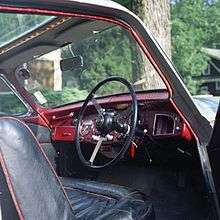 Red Crocodile dash on Silver Flash |
Regency Mark II DF304
The revised Regency DF304 labelled Mark II was announced in October 1954. The new more flowing body was slightly longer with a much longer boot and mudguards and was lower-set. It could now be purchased with a 3½-litre or 4½-litre engine. Again there was a Hooper version, the Empress IIa and III but now also the Sportsman four-light saloon with coachwork by Mulliners (Birmingham).[8] The (at first only) 4½-litre Sportsman with three-piece wrap-around rear window and extra interior luxury features was announced a few days later[9]
- Introductory pricing including tax: 3½-litre / 4½-litre engine
- Regency Mark II saloon: £2,324 / £2,778 with the new Tubeless Tyres fitted as standard equipment
- Regency Sportsman saloon: £2,650 / £3,104[10]
The revised chassis was again made of box section steel and was cruciform braced. The side members rose over the rear axle and were not underslung like the Consort. The suspension was independent at the front using coil springs but retained traditional leaf springs and live axle at the rear. Automatic chassis lubrication continued to be fitted, operating "thermostatically every time the engine warm(ed) up", and the propeller-shaft centre bearing was "prepacked with grease" so did not require lubrication.[11] However, the propeller shaft itself was not served by the system and four grease points required "attention every 1,000 miles".[11] Worm and double roller steering was used.[1] The Regency's hybrid Girling hydro-mechanical brakes were upgraded to fully hydraulic during production of the Regency II.
Performance
The British Motor magazine tested a 3468 cc Regency II saloon in 1955 recording a top speed of 82.8 mph (133.3 km/h) and acceleration from 0-60 mph (97 km/h) in 22.7 seconds and a fuel consumption of 15.7 miles per imperial gallon (18.0 L/100 km; 13.1 mpg-US). The test car cost £2324 including taxes.[1]
Commercial
A spacious interior married with "an abundance of polished hardwood, not only for the facia but also for the door cappings, a floor .... covered with thick pile carpet" and the car's driving qualities will have attracted admiration, but purchase tax on cars was high and in 1954 the UK manufacturer-recommended retail price, including tax, for the standard bodied 3½-litre Daimler Regency was £2,324.[12] That price included a heater, but customer requiring a radio to be fitted would need to find another £48.[12] In the same year Jaguar's recommended UK retail price for the similarly sized (and very effectively promoted) Mark VII was £1,680.[13] (Jaguar buyers also received the heater included in the price, though they were obliged to find an extra £50 for a radio.) The price differential is probably enough to explain why relatively few Daimler Regencys found buyers but it should be pointed out that the Daimler was a much more substantial and durable product assembled with much greater care than Jaguars of that same day and aimed at quite different customers.
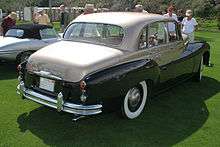
Replacing the Mark II
The Regency Mark II proved little more successful than the first Regency and was superseded in late 1955[14] by the 3½-litre One-O-Four (DF310) which was once again little more than a variant with a more powerful engine.[15][16] The bigger 4½ litre engine went to the new Daimler Regina DF400 or DK400.[17]
Daimler One-O-Four DF310
Announced in October 1955[14] the 3½-litre engine was given a new cylinder head and compression ratio of 7.6:1 generating almost 30% more power (137 bhp (102 kW; 139 PS) @ 4,400 rpm) to push the same 2-tonne Mk II to 104 m.p.h.[18] With upgraded brakes and interior, branded firmly at its tail with a bulky fluted boss bearing a large D in the centre of its back bumper it was advertised as the 100 m.p.h. Daimler One-O-Four. Named because a prototype reached 104 m.p.h. during testing when there were no open-road speed limits. During 1956 a Borg-Warner fully automatic gearbox became available.[14] Seventeen chassis numbers were used by this model and another forty-nine for the corresponding Lady's Model. The special lady's items in the Lady's Model inspired by Lady Docker became optional extras the following year.
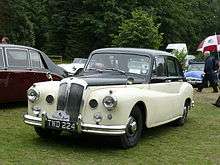 One-O-Four 3½-litre |
 Sportsman 3½-litre |
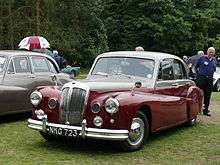 Sportsman 3½-litre |
.jpg) Empress 3½-litre |
.jpg) Empress 3½-litre |
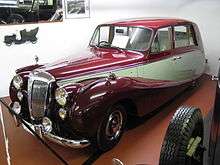 Empress Mk II |
References
- Citations
- 1 2 3 4 5 6 "The 3.5-litre Daimler Regency Mk II Saloon". The Motor. January 19, 1955.
- 1 2 3 4 5 6 7 8 9 10 11 Road Test No. 3/55 (Continental) The Motor Temple Press, London 1955
- ↑ The Motor Show.The Times, Wednesday, Oct 17, 1951; pg. 4; Issue 52134
- ↑ Douglas-Scott-Montagu & Burgess-Wise 1995, p. 260.
- ↑ Daimler Car Cheaper Until Budget Day; Production of the new 3-litre model has been postponed until after the Budget.The Times, Tuesday, Feb 03, 1953; pg. 3; Issue 52536.
- ↑ Douglas-Scott-Montagu & Burgess-Wise 1995, pp. 264–265.
- ↑ Douglas-Scott-Montagu & Burgess-Wise 1995, p. 264.
- ↑ New Big Daimler Models. "The Motor" Vol 106, October 6, 1954
- ↑ Display advertisement, Daimler. The Times, Monday, Oct 04, 1954; pg. 5; Issue 53053.
- ↑ New Daimler Models. The Times, Thursday, Sep 30, 1954; pg. 3; Issue 53050
- 1 2 "Daimler Regency Mark II 3½-litre". Autocar. October 1, 1954.
To reduce the need for maintenance, automatic chassis lubrication is provided thermostatically every time the engine warms up. The propeller-shaft is not served by this system, and four points require attention every 1,000 miles (1609 km). The propeller-shaft bearing, however, is prepacked with grease and does not require lubrication.
- 1 2 "Daimler Regency Mark II 3½-litre". Autocar. October 1, 1954.
- ↑ "Jaguar Mark VII saloon (with overdrive) (road test)". Autocar. January 15, 1954.
- 1 2 3 Details of a new Daimler were announced yesterday. The Times, Friday, Oct 14, 1955; pg. 4; Issue 53351
- ↑ Douglas-Scott-Montagu & Burgess-Wise 1995, p. 269.
- ↑ New Standard Vanguard.The Times, Friday, Oct 14, 1955; pg. 4; Issue 53351
- ↑ Smith 1972, p. 245.
- ↑ High Performance As Part Of The Daimler Tradition. The Times, Tuesday, Jul 10, 1956; pg. 5; Issue 53579.
- Sources
- Douglas-Scott-Montagu, Edward John Barrington & Burgess-Wise, David (1995). Daimler Century: The full history of Britain's oldest car maker. Sparkford, Nr Yeovil, Somerset, UK: Patrick Stephens. ISBN 1 85260 494 8.
- Smith, Brian E. (1972). The Daimler Tradition. Isleworth, UK: Transport Bookman. ISBN 0851840043.
External links
- Standard saloon by Barker. Announcement, company internal news item October 1951
- Special Sports fixed head coupé by Barker DF302
- Regency DF304 Mark II
- Empress II saloon by Hooper
- Sportsman saloon by Barker, 4½-litre
- Silver Flash for Lady Docker
| « previous — Daimler road car timeline, 1945–1979 — next » | |||||||||||||||||||||||||||||||||||||||
|---|---|---|---|---|---|---|---|---|---|---|---|---|---|---|---|---|---|---|---|---|---|---|---|---|---|---|---|---|---|---|---|---|---|---|---|---|---|---|---|
| Type | 1940s | 1950s | 1960s | 1970s | |||||||||||||||||||||||||||||||||||
| 5 | 6 | 7 | 8 | 9 | 0 | 1 | 2 | 3 | 4 | 5 | 6 | 7 | 8 | 9 | 0 | 1 | 2 | 3 | 4 | 5 | 6 | 7 | 8 | 9 | 0 | 1 | 2 | 3 | 4 | 5 | 6 | 7 | 8 | 9 | |||||
| Sports car | Conquest Roadster | Conquest 3–seat dhc | SP250 | ||||||||||||||||||||||||||||||||||||
| Sports saloon | Special Sports | Conquest Century | |||||||||||||||||||||||||||||||||||||
| Sportsman | |||||||||||||||||||||||||||||||||||||||
| Saloon | DB18 | Conquest | 2.5 V8 | V8-250 | |||||||||||||||||||||||||||||||||||
| Consort | |||||||||||||||||||||||||||||||||||||||
| Large saloon | DE 27 | Regency | Regency Mk II | One-O-Four | Majestic | Sovereign 420 | Sovereign XJ6 Mk I | Sovereign XJ6 Mk II | |||||||||||||||||||||||||||||||
| Regency 4½ Litre (DF 304) | Majestic Major | Double Six Mk I | Double Six Mk II | ||||||||||||||||||||||||||||||||||||
| Flagship | DE 27 | Regina | DK400 | DR450 | DS420 | ||||||||||||||||||||||||||||||||||
| DE 36 | |||||||||||||||||||||||||||||||||||||||
| Ownership | Birmingham Small Arms | Jaguar Cars | BMH | British Leyland | |||||||||||||||||||||||||||||||||||